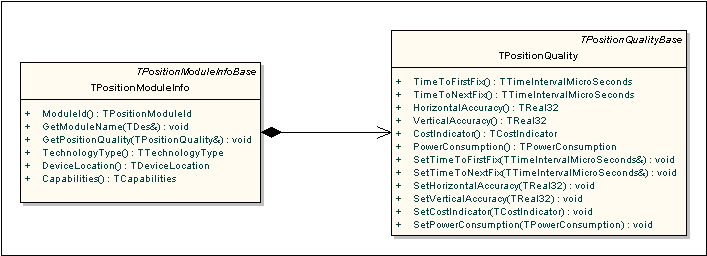Positioning Modules
This document describes the classes that give information about Positioning Modules.
Purpose
This document is an overview of the Positioning Module information that is available to client applications using the Location Acquisition API. A Positioning Module is a software component that allows the Location Server to communicate with the mobile device hardware that obtains position data.
See How to Use Positioning Module Information for an example of how to get Positioning Module information using the Location Acquisition API.
Types of Positioning Modules
In mobile devices there may be several Positioning Modules:
Positioning Module information classes
The classes TPositionModuleInfo and TPositionQuality hold information about the capabilities of Positioning Modules and the quality of position information that they can provide. Figure 1 illustrates these classes.
TPositionModuleInfo
TPositionModuleInfo describes a Positioning Module. This description includes:
-
The technology type used by the Positioning Module.
A Positioning Module can use positioning technology which is terminal-based (such as GPS), network based, or a combination of the two (such as A-GPS). The method TPositionModuleInfo::TechnologyType() returns this information.
-
The capabilities of the Positioning Module.
Different Positioning Modules have different capabilities which depend on the Positioning Module technology type. Most Positioning Modules have the capability to provide latitude and longitude information. Some Positioning Modules can also supply altitude information, course information and satellite data. This information is returned by the method TPositionModuleInfo::Capabilities() as a bit mask of type TPositionModuleInfo::TCapabilities .
-
A unique identifier returned by TPositionModule::ModuleId() .
This identifier is used to select a specific Positioning Module when a client application wishes to use a specific positioning technology to obtain a location fix.
A TPositionModuleInfo object obtains a reference to its TPositionQuality object by calling TPositionModuleInfo::GetPositionQuality() .
TPositionQuality
TPositionQuality describes the quality of information that a Positioning Module can provide. The quality describes the accuracy of information, the time to obtain a location fix, the cost of obtaining the fix and power consumption:
-
TPositionQuality::HorizontalAccuracy() and TPositionQuality::VerticalAccuracy() return location accuracy information.
-
TPositionQuality::TimeToFirstFix() and TPositionQuality::TimeToNextFix() return a typical time to get a location fix as a TTimeIntervalMicroSeconds value.
-
TPositionQuality::CostIndicator() returns a cost for using the Positioning Module to get location information. The value returned is an estimate, not a precise cost value and is of type TPositionQuality::TCostIndicator . The cost estimate helps the location server to make a choice of the Positioning Module to use to get a location fix when a specific Positioning Module is not chosen by a client application.
-
TPositionQuality::PowerConsumption() returns an estimate of power consumption for using a Positioning Module. This estimate is of type TPositionQuality::TPowerConsumption and as with cost, it helps the Location Server make a choice of Positioning Module to use to get a location fix.
Copyright ©2010 Nokia Corporation and/or its subsidiary(-ies).
All rights
reserved. Unless otherwise stated, these materials are provided under the terms of the Eclipse Public License
v1.0.
